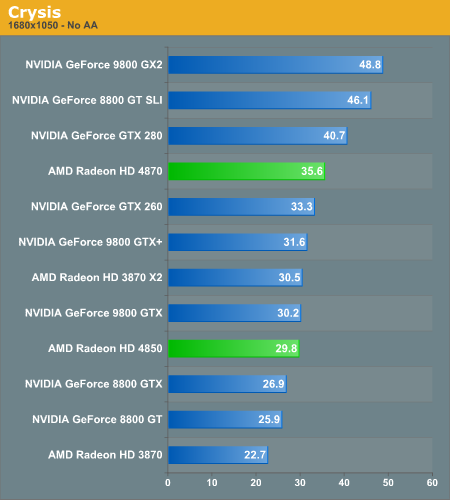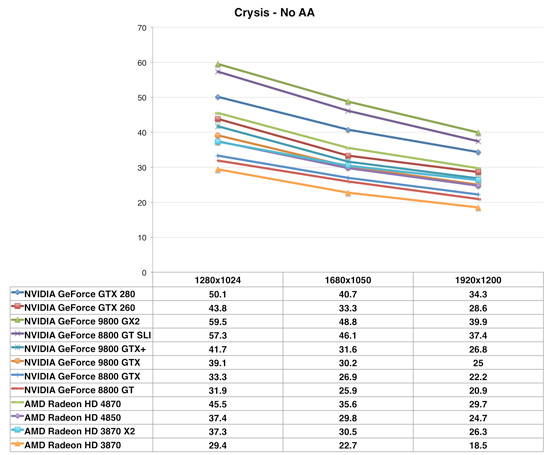The Radeon HD 4850 & 4870: AMD Wins at $199 and $299
by Anand Lal Shimpi & Derek Wilson on June 25, 2008 12:00 AM EST- Posted in
- GPUs
Crysis
Crysis is a game that can beat down all cards. We're once again using the high settings with the shaders at very high, and even at a fairly tame resolution of 1680x1050 only 8 cards manage to get past the magical 30fps rate, with nearly half of those are just squeaking by. Crysis is particularly punishing on the HD3000 series cards at these kinds of settings, where only the HD3870 X2 was competitive without resorting toCrossfire. This makes the placement of the HD4000 series all the more important.

What we see with the 4870 is very promising. Here it leapfrogs the $100 more expensive GTX 260 and delivers 7% more performance at the same time, delivering manageable framerates. It does struggle a bit to separate itself from its cheaper brother the 4850 however, with only a 20% boost in performance for a 50% boost in price. This isn't unexpected of course, it's almost exactly in line with the shader power difference between the two and we've known that this test is shader-bound for some time, but we're not seeing the memory bandwidth make even a slight difference here even at the more unplayable 1900x1200 resolution.
Neither HD4000 card can crack 30fps at higher resolutions however, after 1680x1050 you either need to turn the settings down or start throwing down additional cash for one of NVIDIA's more expensive cards or a Crossfire/SLI solution. In either case, this situation highlights the fact that on a dollar-for-dollar basis, the HD4000 series has negated NVIDIA's commanding lead with Crysis merely two weeks ago.











215 Comments
View All Comments
NullSubroutine - Wednesday, June 25, 2008 - link
It scaled more than 100% in a few games?DerekWilson - Wednesday, June 25, 2008 - link
greater than 100% scaling is due to margin of error combination for both single card and dual card tests in the vast majority of cases.we also tested single card performance on an nvidia system and crossfire performance on an intel system, so the different computers will also add margin of error.
two card solutions generally don't scale at greater than 100% except in extraordinarily odd situations (where rebalancing loads might help with scaling on both individual cards -- but that's odd and rare).
Sind - Wednesday, June 25, 2008 - link
Why no 260 and 280 SLI?ImmortalZ - Wednesday, June 25, 2008 - link
Because, with that kind of money, one can an entire system with one 48xx :PAlso, page 10 appears to be broken.
Lifted - Wednesday, June 25, 2008 - link
No 260 or 280 SLI in the benchmarks, but they included them in the power charts. Odd.Anand Lal Shimpi - Wednesday, June 25, 2008 - link
The power data was simply taken from the GTX 280 review, we just added to the list.As for the GTX 280 SLI numbers, we didn't include them as it it's mostly out of the price range of the Radeon HD 4870 ($1300 vs. $600 for two 4870s). We can always go back and redo the graphs to include them if you guys would like, but in the interim I would suggest looking at the GTX review to get comparison numbers.
Take care,
Anand
DerekWilson - Wednesday, June 25, 2008 - link
we actually only have one GTX 260, so we can't test thatClauzii - Wednesday, June 25, 2008 - link
Yes, and the click to enlarge doesn't work.And believe it or not, posting right now from a AT page that looks like 1994...!
ImmortalZ - Wednesday, June 25, 2008 - link
Insert a buy in there. Need edit!TonyB - Wednesday, June 25, 2008 - link
but can it play crysis?